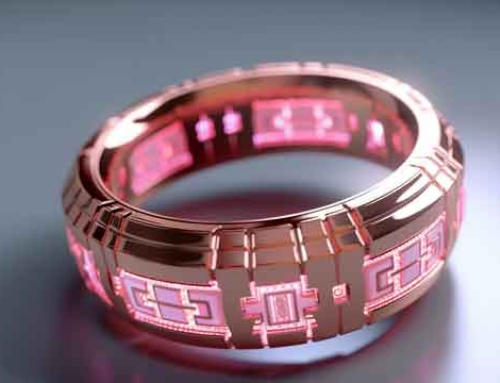Retail has shifted since the start of Covid-19, and the drive toward digital has become more pronounced. Some 90% of jewelry retailers now have online platforms, according to Bain & Company’s Global Diamond Industry 2021–22 report. “The pandemic rapidly accelerated e-commerce, even for independent US retailers,” it states.
The move is a direct result of retailers looking to meet customers where they shop.
“Consumers are buying more online than before the pandemic,” says John Harmon, senior analyst at global advisory and research firm Coresight Research, which specializes in retail and technology. “While sheltering at home, they were disconnected from retail stores as gathering places, and they discovered new online shopping channels. Now, consumers are more open to online shopping, yet their attention is more fragmented.”
Nearly half of consumers are still reluctant to visit public places in general, he adds, citing a Coresight consumer survey from April.
Even stores that had previously invested in e-commerce have seen a shift.
“We already had online scheduling, and we were already doing FaceTime for people who were long-distance,” says Babs Noelle, owner of Alara Jewelry in Bozeman, Montana. “But pre-pandemic to now, what’s changed is the volume of business we’re doing.”
She attributes this to customers continuing to spend their discretionary funds on jewelry instead of luxury travel. “And probably the biggest change I’ve seen is people who never shopped online before for jewelry, suddenly figuring out how to do it.”
Covid-19 has helped more consumers get accustomed to digital, agrees Mike Simoncic, managing director at Alvarez & Marsal Consumer Retail Group.
“The consumer has shifted their behavior to be more online and is therefore more conditioned to do things in a virtual environment,” he says. “In terms of what’s changed for digital, virtual experiences are expanding efficiently and rapidly. The biggest shift is the idea of the consumer’s willingness to purchase and buy online.”
Yet stores that embrace technology are still seeking a balance between digital and in-person connection.
“A lot of us got used to buying and selling out of our living rooms,” says Matt O’Desky, owner of The Diamond Room in Texas, which has private showrooms in Austin and Dallas but has seen an increasing number of out-of-state clients since the pandemic began. “Sometimes we have our clients take pictures of their hands, and we can render it. But I think there needs to be a happy balance. We don’t want to lose that interaction. I don’t want to go to virtual appointments. I want to meet with people in person.”
Seamless experiences
Instead of thinking of e-commerce and brick-and-mortar as separate entities, Harmon says it’s important to see the two as part of the same shopping journey.
“The jewelry industry is leveraging technology to offer consumers the same experience that they would have in a store,” he says. “Retailers are offering consumers the ability to try on products through advances in AR technology, or customize products to their exact specifications and speak with consultants — some through virtual chats, and others live, just as if consumers were in a store.”
Harmon believes these advances lead to higher conversions both online and in-store, because consumers are more informed and confident about their purchases. “This is particularly important for high-value segments like jewelry and luxury,” he says. “For example, Signet Jewelers reported that at its retail banner Ernest Jones, 20% of its in-store business is now the result of appointments that were made online. And of those appointments, over 70% result in a sale that’s four times higher, on average, than what a walk-in customer spends.”
Alara Jewelry embraces the idea that customers will be doing their research online, or that they’ll want information after store hours, says Noelle. “A lot of people love to do the initial dipping their toe in the water online, without having to come to a store. If they text us after 6 p.m., they’ll get an automated message telling them we’re gone for the day. Then, the very next morning, they will get a response from us.”
She does much of her initial communication digitally, especially with younger customers. “I don’t know why people shop for jewelry in the middle of the night, but our website has blown up since Covid-19,” she remarks. That’s why she believes it’s so important for businesses to be thoughtful about their online image. “I don’t think bells and whistles are important; I think having a high-functioning website is important, because it instills confidence.”
How tech can help
Online shopping is just one step in the technology journey consumers are making, according to Harmon.
“Chatbots and digital shopping assistants can help retailers deal with the labor shortage,” he says. “And they’re able to work 24/7, when stores are closed.”
Technology can also make a salesperson’s job easier and more effective, he adds. “Handheld devices such as tablets can put a customer’s purchase history in the sales associate’s hands. And artificial intelligence/machine learning (AI/ML) excels at finding relationships among data and making forecasts, and can assist in making intelligent product recommendations.”
Noelle uses customer relationship management (CRM) software to simplify and automate certain interactions. “For instance, we remind customers to get their appraisal redone every three years,” she says. “By sending those emails out every three years, we become the favorite of the insurance companies and the clients, and we know that we have this constant income flow from just an email that goes out without us even knowing it’s going out.”
Noelle also offers a downloadable engagement-ring buyer’s guide. If a customer signs up, she will mail them a free ring-sizer and a loupe, and teach the client over the phone how to use them.
“We have probably 40 automated campaigns, and we’re constantly adding them,” she says. “It’s amazing how much business that generates.”
Cryptocurrency and NFTs
This may just be the tip of the technology iceberg, says O’Desky. “We haven’t even begun with the changes that are coming with digital. And our industry in general is always kicking and screaming toward evolving. That’s why so many jewelers had an issue with lab-grown diamonds and lab-grown diamond technology. And the big, big boom — the big thing with non-fungible tokens (NFTs) and cryptocurrency — has yet to even come.”
Luxury-goods manufacturers are already beginning to incorporate NFTs into their product lines, says Simoncic. NFTs are unique digital collectors’ items — in the same way a luxury handbag or a custom ring is one of a kind, only in digital form. “Now, when you buy a Gucci bag, you actually get an NFT — a digital asset that has an authentication code. So if you ever wanted to sell that Gucci bag, you have an authentication code tied to it.”
Simoncic expects more retailers to adopt this technology. “As transparency becomes more standardized, jewelers who don’t provide that as a standard will suffer. I think independent jewelers will find it harder to compete. The consumers will demand this type of information.”
O’Desky, who plans to start incorporating NFTs into his product offerings, says he sees a lot of opportunity. “There’s so much value and future potential in NFTs,” he says. “You can buy the NFT of an item, and it’s in a secured holding location.”
The race has begun
Cryptocurrency is also beginning to make waves, but it’s too soon to know how big a role it will play, says Simoncic.
“Cryptocurrency is in the very early stages,” he states. “People who are eco-conscious, probably technology-savvy, will lead to more demand for lab diamonds in the future, and then we’ll probably see a cross-section of those customers with NFTs and cryptocurrency.”
O’Desky says he’s curious but cautious.
“Cryptocurrency eliminates the risk of having a stolen credit card given to you,” he acknowledges. “And it’s going to change how we transact. It’s just a matter of doing something new. It’s just another thing that we will eventually adapt to. This is almost a race, and it’s a matter of when you jump on board.”
Noelle isn’t ready to jump just yet, though.
“For every type of different technology I’ve put into play, there’s a learning curve,” she says. “Everything is buggy. So with something like crypto, until I start getting enough requests, I don’t see myself getting entrenched in what will invariably be something that requires more time than I was ever promised it would take to implement it. You always have to look at your risk and your reward and how much time you have.”
One of the more surprising aspects of the tech boom is the new customers it’s bringing in, she adds. “Covid-19 brought older people into online shopping who had never online-shopped before. This was already happening before, but Covid-19 kind of accelerated it.”
Before the pandemic, she says, stores were also more inclined to let customers come to them, but that dynamic has since changed. “People in the jewelry industry were not gearing up to meet the consumer where the customer was comfortable. Now it’s much more important that jewelers meet their customers where they are.”







